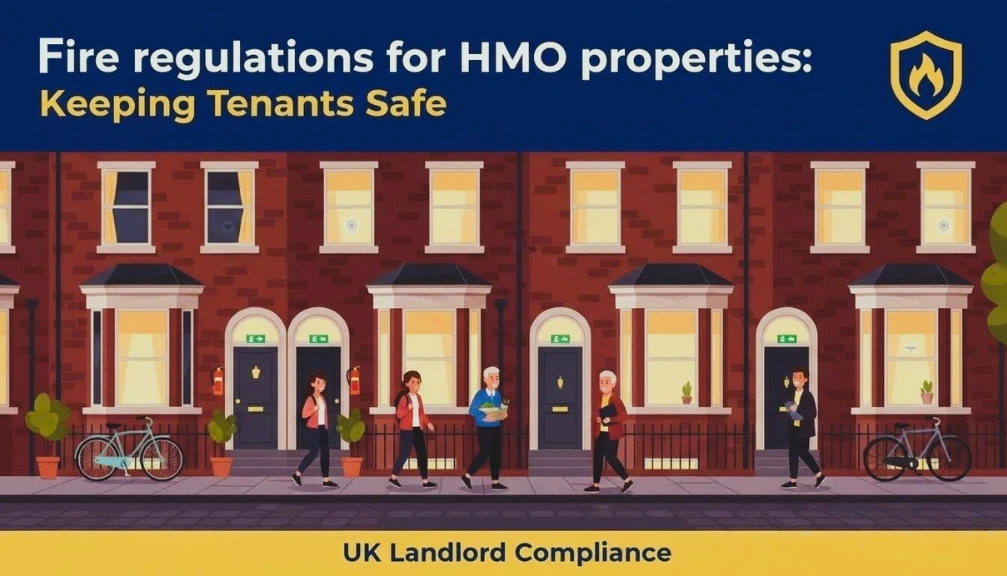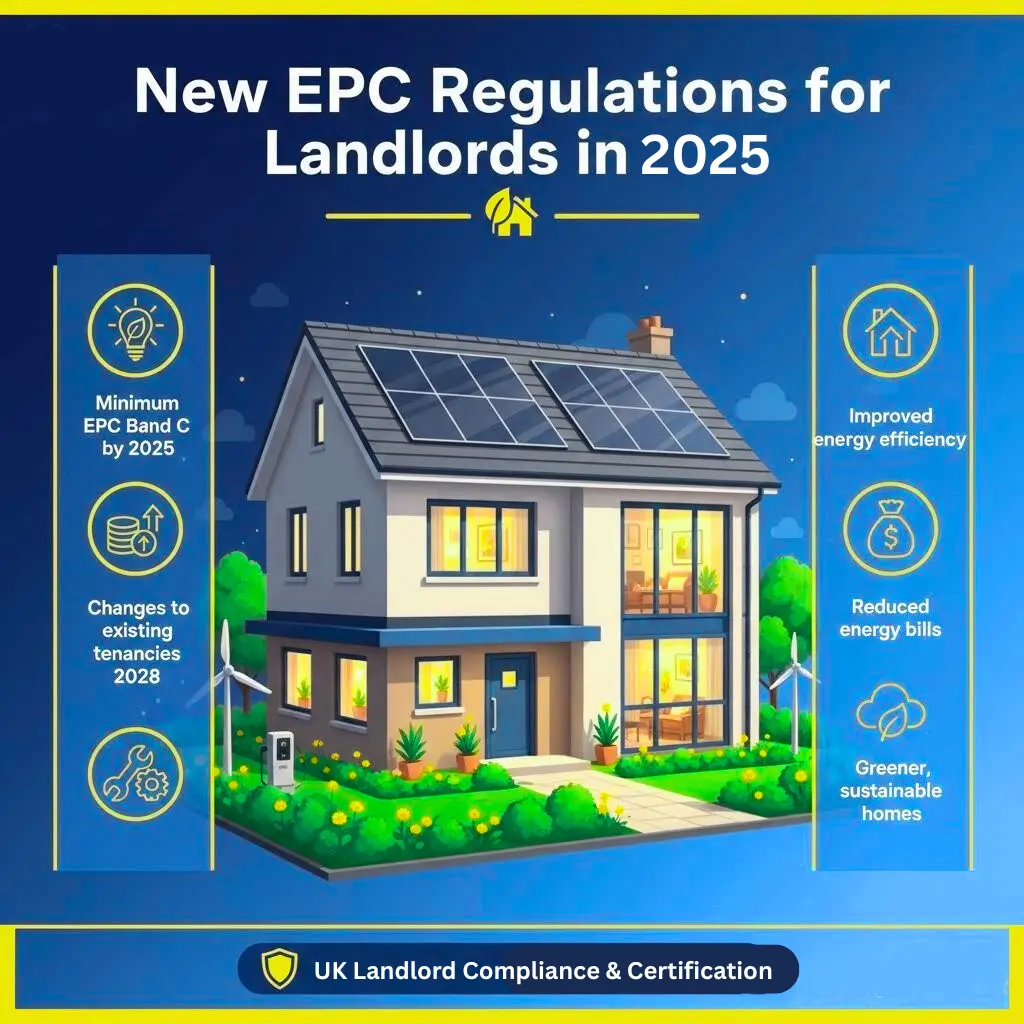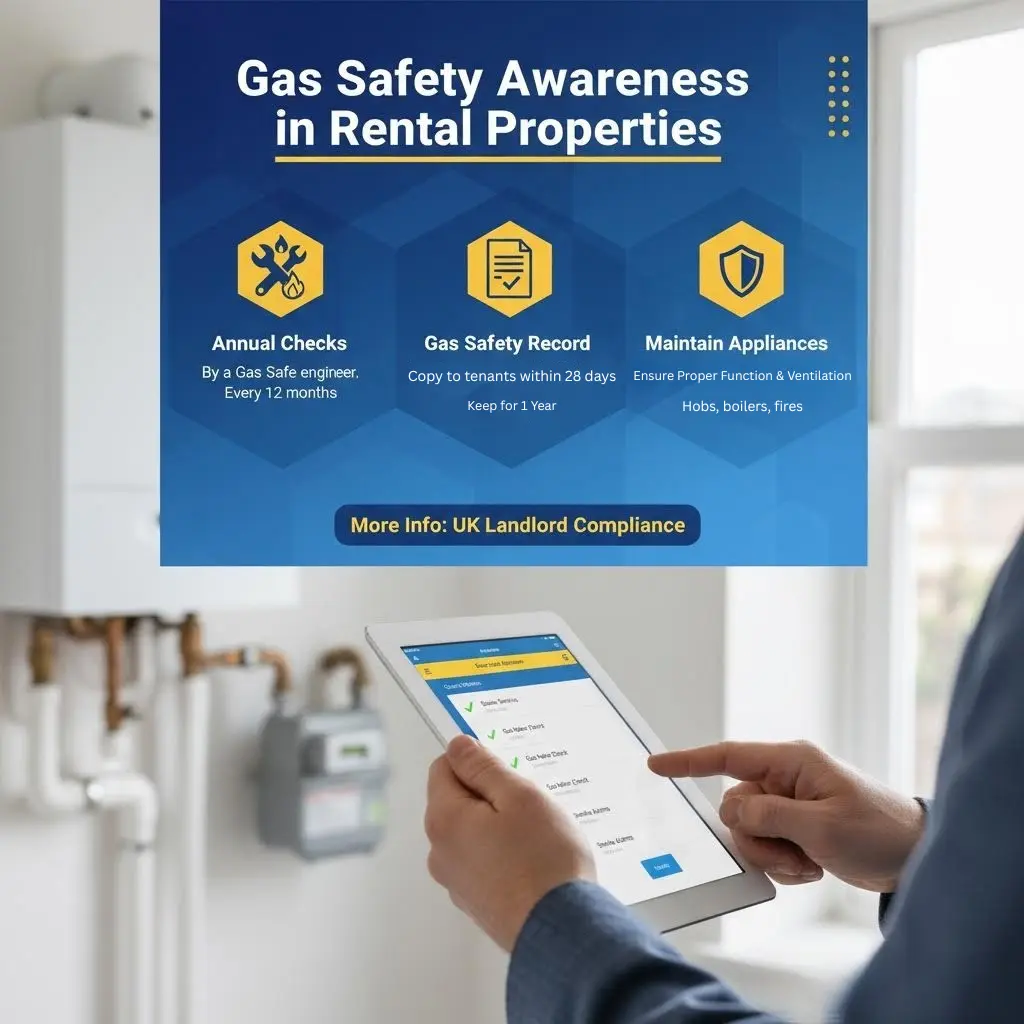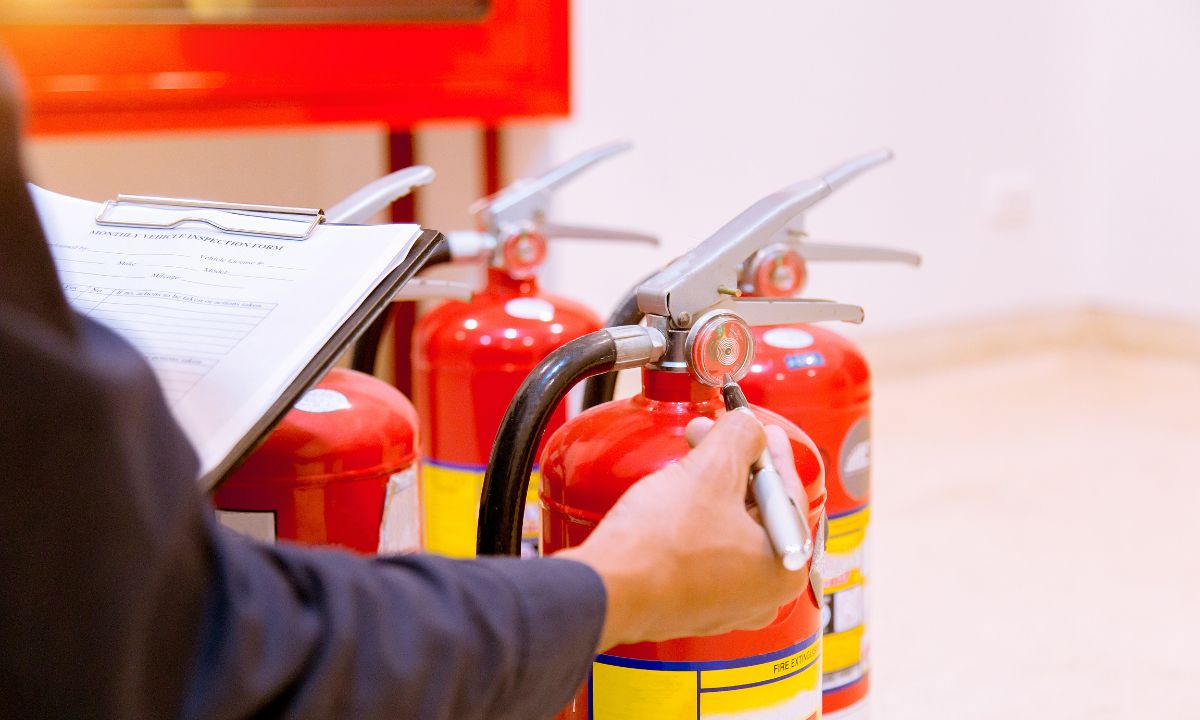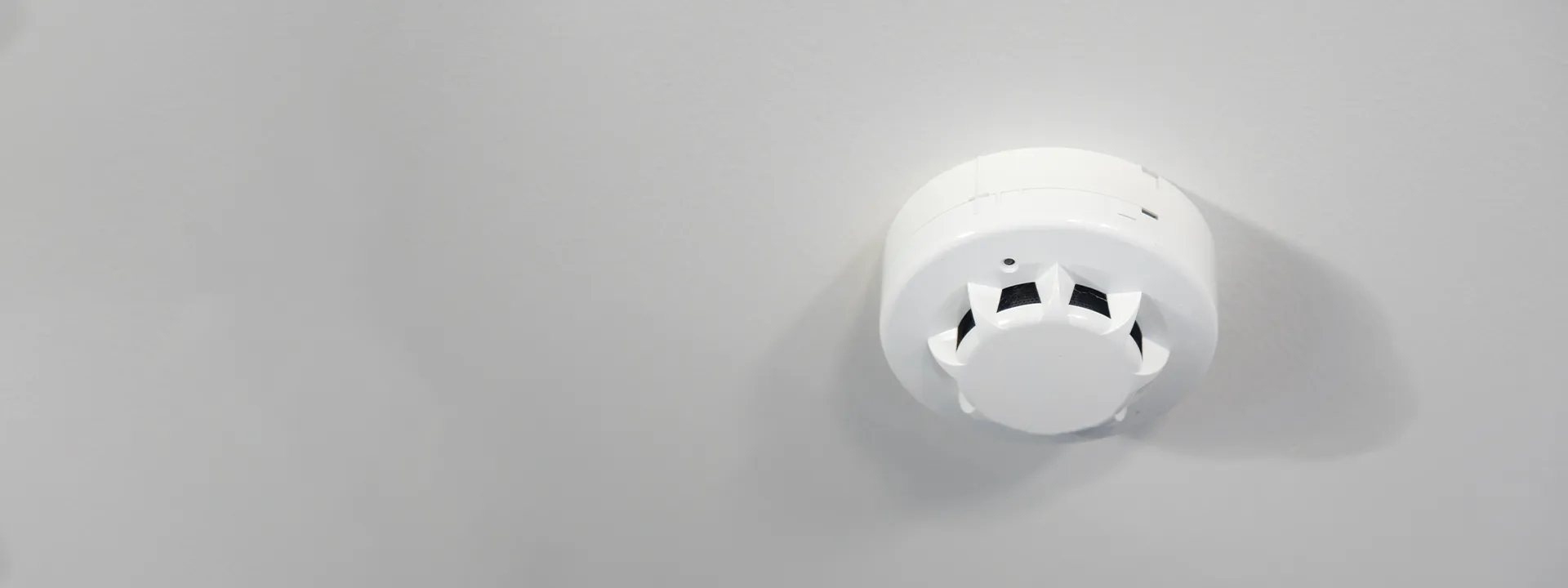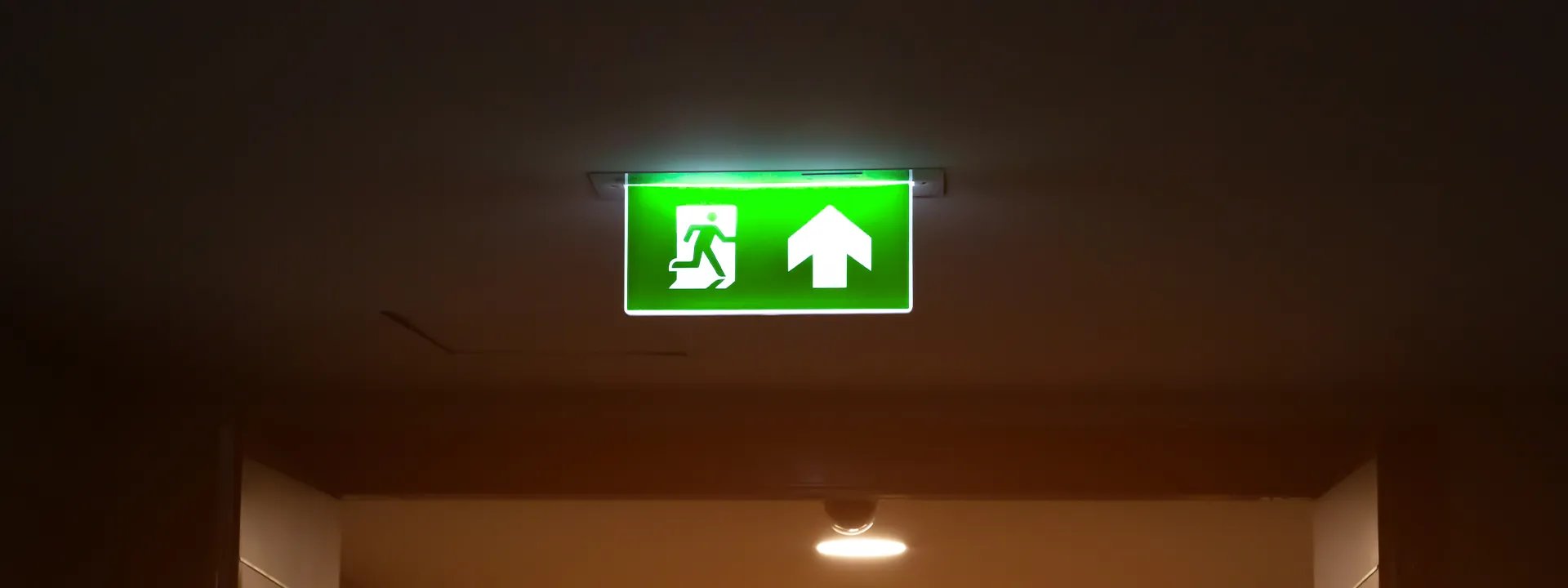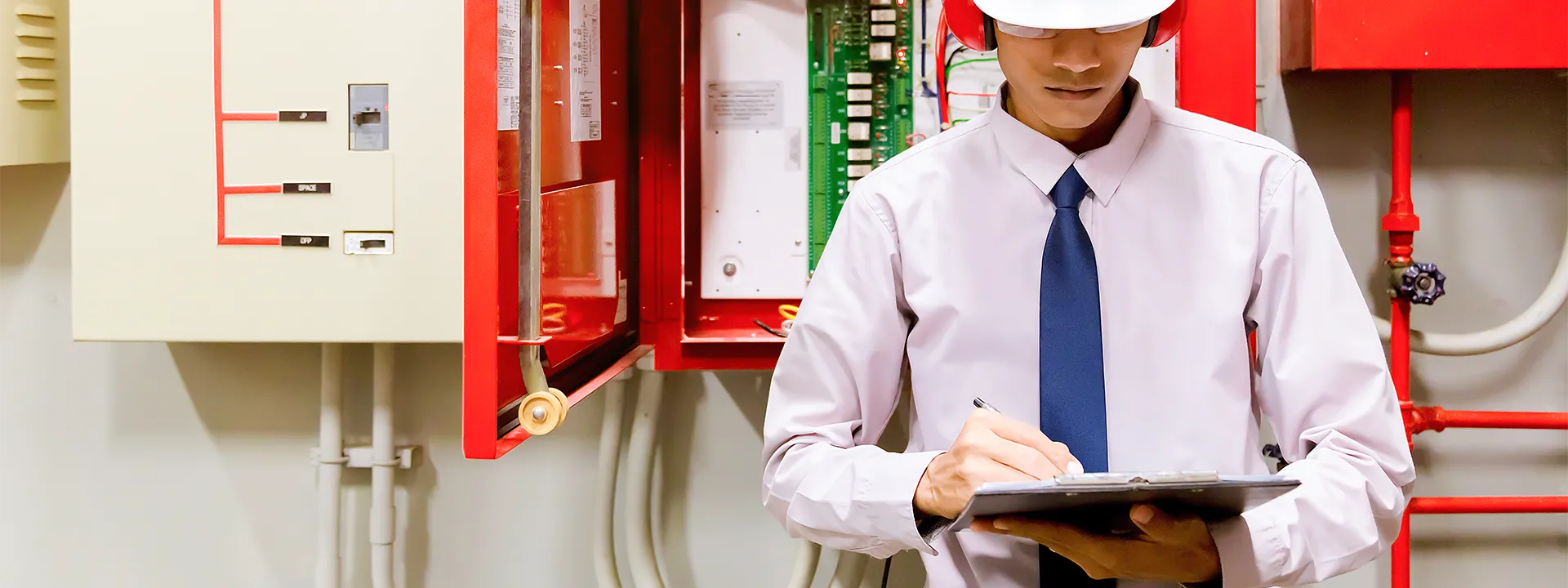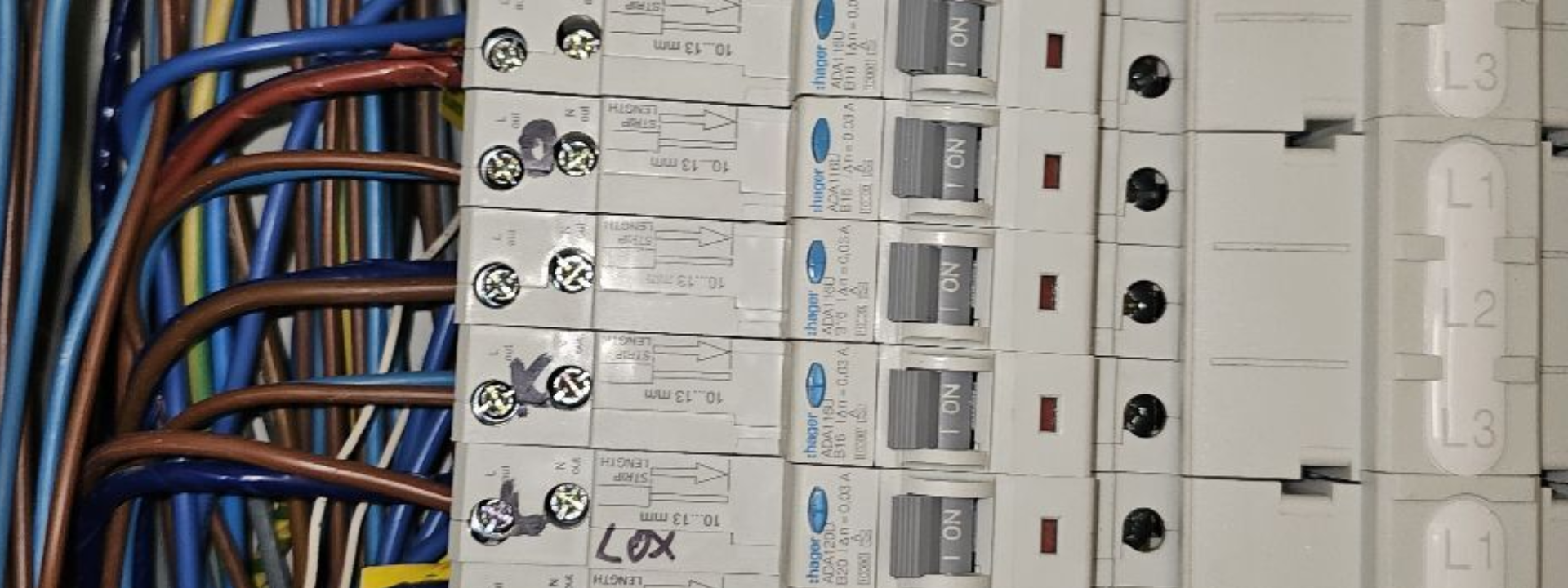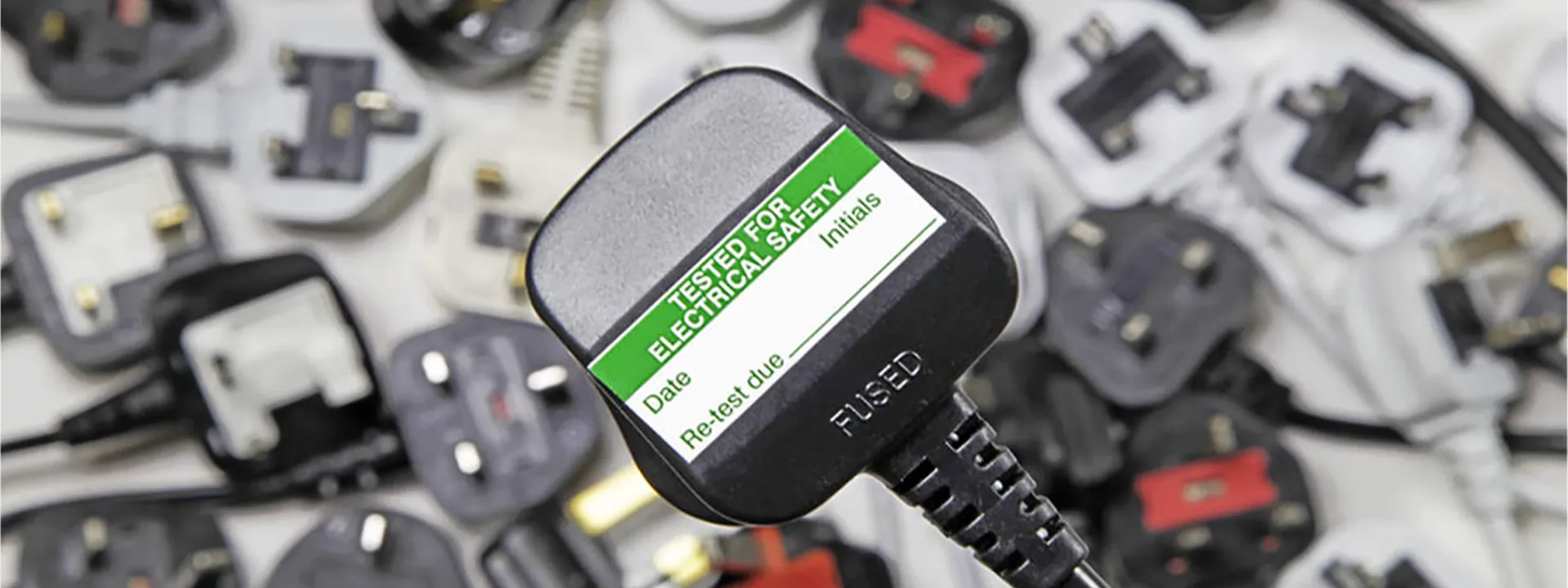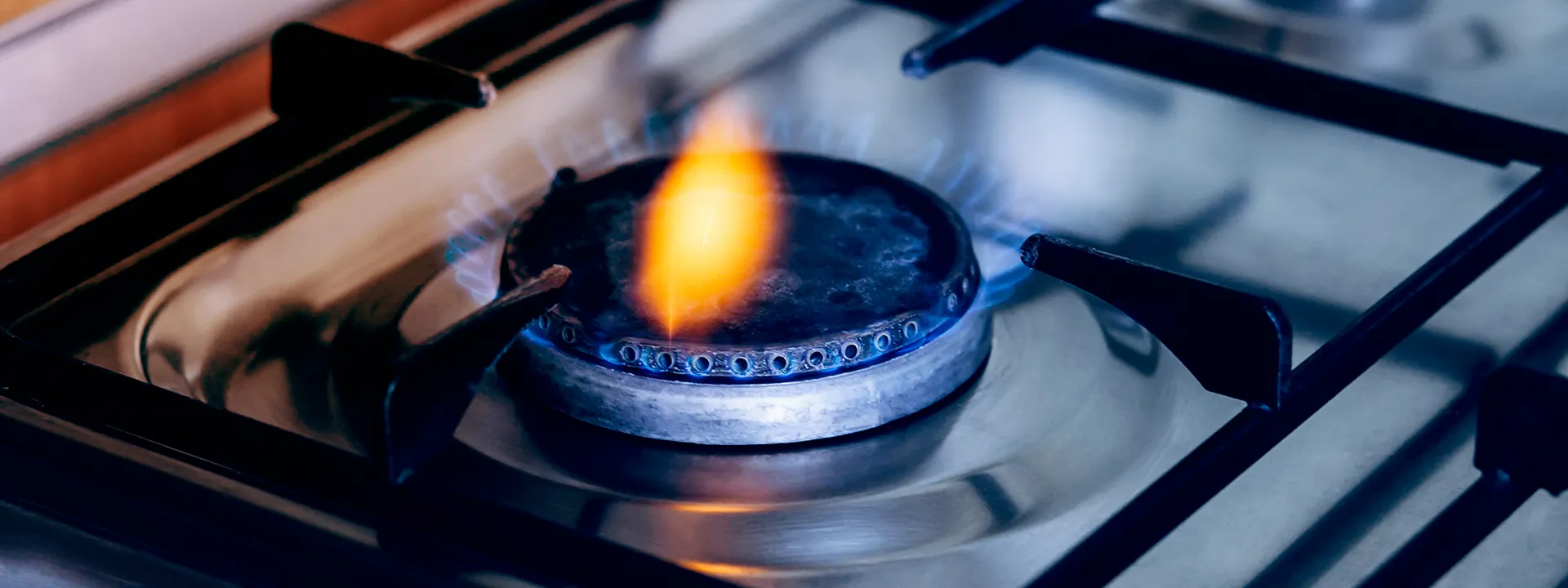Around 44% of fires occur in homes across the UK each year. That’s why Fire safety isn’t about paperwork, it’s a legal duty for landlords. Every landlord must ensure their rental property is safe from fire. To do this, landlords follow fire safety rules and keep fire equipment checked and maintained. Regular fire safety check for landlords are essential to identify risks and keep tenants safe.
In this guide, we explain everything landlords need to know in a simple and easy-to-understand way. We cover important fire safety checks for landlords, gas safety checks, fire risk assessments, and electrical safety and more. Let’s get started!
What Are the Legal Requirements for Fire Safety in Rental Properties?
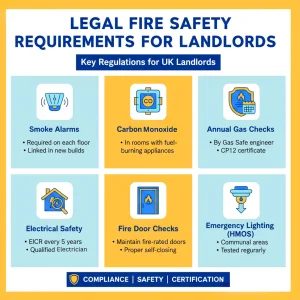
If you’re a landlord of rental properties or flats in London, you need to follow fire safety regulations. These rules are created to protect your tenants and keep your property safe from fire. A fire safety check for landlords is essential to keep homes safe. Under UK law, landlords must comply with fire safety rules to avoid fines. The rules are:
![]() The Regulatory Reform (Fire Safety) Order 2005.
The Regulatory Reform (Fire Safety) Order 2005.![]() The Smoke and Carbon Monoxide Alarm (Amendment) 2022 Regulations.
The Smoke and Carbon Monoxide Alarm (Amendment) 2022 Regulations.![]() Electrical Safety Standards in the Private Rented Sector (England) Regulations.
Electrical Safety Standards in the Private Rented Sector (England) Regulations.![]() Annual Gas Safety Certificate requirements.
Annual Gas Safety Certificate requirements.
Legal Fire Safety Guidance for Landlords:
![]() A working smoke alarm on every floor.
A working smoke alarm on every floor.![]() Carbon monoxide alarms in any room with a solid fuel or gas appliance.
Carbon monoxide alarms in any room with a solid fuel or gas appliance.![]() A valid fire risk assessment.
A valid fire risk assessment.![]() Clearly marked and unobstructed escape routes.
Clearly marked and unobstructed escape routes.![]() Fire doors and emergency lighting were required.
Fire doors and emergency lighting were required.![]() Annual gas safety check.
Annual gas safety check.![]() Electrical appliance testing and certification.
Electrical appliance testing and certification.![]() Safety info and fire safety precautions for tenants at the start of the tenancy.
Safety info and fire safety precautions for tenants at the start of the tenancy.
Current Fire Safety Regulations for Landlords
Take a look at the fire safety for landlords regulations you must follow if you manage a rental property:
![]() The Smoke and Carbon Monoxide Alarm (Amendment) Regulations 2022 require that landlords install at least one smoke alarm on each storey used as living accommodation, and a carbon monoxide alarm in any room with a fixed combustion appliance (excluding gas cookers) from 1 October 2022.
The Smoke and Carbon Monoxide Alarm (Amendment) Regulations 2022 require that landlords install at least one smoke alarm on each storey used as living accommodation, and a carbon monoxide alarm in any room with a fixed combustion appliance (excluding gas cookers) from 1 October 2022.![]() Under the national guidance for private rented sector landlords, you must provide working smoke alarms and carbon monoxide alarms at the start of each tenancy.
Under the national guidance for private rented sector landlords, you must provide working smoke alarms and carbon monoxide alarms at the start of each tenancy.![]() The landlord fire safety check must include electrical safety: you must ensure electrical installations and wiring are safe and tested (for example, every five years) and provide proof of inspection.
The landlord fire safety check must include electrical safety: you must ensure electrical installations and wiring are safe and tested (for example, every five years) and provide proof of inspection.![]() For gas safety, you must ensure that any gas appliances are safely installed, maintained by a registered engineer, and that an annual gas safety certificate or gas safety check is provided to tenants.
For gas safety, you must ensure that any gas appliances are safely installed, maintained by a registered engineer, and that an annual gas safety certificate or gas safety check is provided to tenants.![]() Where you own an HMO (house of multiple occupation) or multi‑occupied building, extra fire safety measures apply: fire risk assessment, escape route checks, fire doors, common areas, etc.
Where you own an HMO (house of multiple occupation) or multi‑occupied building, extra fire safety measures apply: fire risk assessment, escape route checks, fire doors, common areas, etc.![]() Local authority enforcement: If you fail to comply with the regulations for landlords, you could face remedial notices, fines or licensing consequences.
Local authority enforcement: If you fail to comply with the regulations for landlords, you could face remedial notices, fines or licensing consequences.
Following the above landlord fire safety checks and keeping records can help you avoid a huge financial loss.
Penalties for Non-Compliance with Fire Safety Laws
Under the Regulatory Reform (Fire Safety) Order 2005, landlords are required to ensure that their properties follow fire safety regulations. If a landlord doesn’t follow these rules, the consequences are:
![]() Fines: Landlords can get big fines if they don’t follow fire safety rules. In 2017, one company was fined £250,000 by the London Fire Brigade, which was their largest fine ever after a serious fire where 13 people had to be rescued.
Fines: Landlords can get big fines if they don’t follow fire safety rules. In 2017, one company was fined £250,000 by the London Fire Brigade, which was their largest fine ever after a serious fire where 13 people had to be rescued.![]() Criminal Charges: Serious cases can lead to court. For example, a landlord got 8 months in prison (suspended) for breaking fire safety laws.
Criminal Charges: Serious cases can lead to court. For example, a landlord got 8 months in prison (suspended) for breaking fire safety laws.![]() Unlimited Fines: Courts can give fines with no limit if the rules are broken.
Unlimited Fines: Courts can give fines with no limit if the rules are broken.![]() Jail Time: In very serious cases, people can go to jail for up to 2 years.
Jail Time: In very serious cases, people can go to jail for up to 2 years.![]() Enforcement Notices: Fire officers can order landlords to fix problems by a set date.
Enforcement Notices: Fire officers can order landlords to fix problems by a set date.![]() Prohibition Notices: If a place is very unsafe, landlords can be told to stop using all or part of it until it is safe.
Prohibition Notices: If a place is very unsafe, landlords can be told to stop using all or part of it until it is safe.![]() Insurance Cancelled: Not following fire safety rules can cancel insurance, which means landlords pay for damages themselves.
Insurance Cancelled: Not following fire safety rules can cancel insurance, which means landlords pay for damages themselves.![]() Bad Reputation: Not keeping fire safety rules can hurt a landlord’s reputation and make it harder to rent out their properties.
Bad Reputation: Not keeping fire safety rules can hurt a landlord’s reputation and make it harder to rent out their properties.
Documentation Requirements for Fire Safety Compliance
When it comes to fire safety check landlords handle, keeping good records is important. Here’s what that means:
![]() A valid fire safety certificate.
A valid fire safety certificate.![]() Hard copies of the building’s safety documents.
Hard copies of the building’s safety documents.![]() Copies of the building’s floor and orientation plan of the building.
Copies of the building’s floor and orientation plan of the building.![]() Details of the responsible person.
Details of the responsible person.![]() Relevant fire safety instructions for tenants.
Relevant fire safety instructions for tenants.![]() All fire safety checks, emergency lighting checks, and fire door safety checks.
All fire safety checks, emergency lighting checks, and fire door safety checks.![]() A record of quarterly checks, especially for HMO and multi-occupied units.
A record of quarterly checks, especially for HMO and multi-occupied units.
What Are the New Fire Safety Rules for Landlords in 2025?
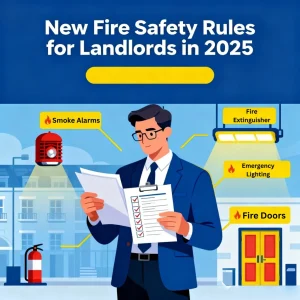
Landlords fire safety responsibilities are a legal duty. To ensure the safety of tenants, landlords must follow the new regulations in 2025. Here we list all these new rules, take a look:
Fire Door Maintenance
![]() For buildings over 11 meters, landlords must check fire doors carefully.
For buildings over 11 meters, landlords must check fire doors carefully.![]() Doors should close properly, be free of damage, and fit correctly in the frame.
Doors should close properly, be free of damage, and fit correctly in the frame.![]() Keep detailed records of inspections, defects, and actions taken.
Keep detailed records of inspections, defects, and actions taken.![]() Use a checklist to log inspections and ensure all records are maintained.
Use a checklist to log inspections and ensure all records are maintained.
Fire Risk Assessments
![]() A written fire risk assessment is mandatory for all businesses.
A written fire risk assessment is mandatory for all businesses.![]() The assessment must include the full inspection, not just the main issues.
The assessment must include the full inspection, not just the main issues.![]() Keep the complete assessment on file to meet legal requirements.
Keep the complete assessment on file to meet legal requirements.
Smoke and Carbon Monoxide Alarms![]() Updated BS 5839-1:2025 standard prefers smoke detectors in bedrooms and other sleeping areas.
Updated BS 5839-1:2025 standard prefers smoke detectors in bedrooms and other sleeping areas.![]() Carbon monoxide alarms are required if a room has a gas appliance or sa olid fuel burner.
Carbon monoxide alarms are required if a room has a gas appliance or sa olid fuel burner.![]() Landlords must check all alarms at the start of each tenancy.
Landlords must check all alarms at the start of each tenancy.![]() Repair or replace any faulty smoke or carbon monoxide alarms promptly.
Repair or replace any faulty smoke or carbon monoxide alarms promptly.
Fire Alarm Systems for HMOs![]() Houses in multiple occupation (HMOs) with three or more stories must have a central fire alarm panel.
Houses in multiple occupation (HMOs) with three or more stories must have a central fire alarm panel.![]() All alarms must be mains-powered and interconnected.
All alarms must be mains-powered and interconnected.![]() Systems must be maintained by a competent person following the manufacturer’s instructions.
Systems must be maintained by a competent person following the manufacturer’s instructions.![]() Landlords must keep records of all checks and servicing for local authorities.
Landlords must keep records of all checks and servicing for local authorities.
Emergency Evacuation Plans![]() Landlords must create Personal Emergency Evacuation Plans (PEEPs) for residents who may need help during a fire.
Landlords must create Personal Emergency Evacuation Plans (PEEPs) for residents who may need help during a fire.![]() PEEPs must be reviewed and updated at least once a year.
PEEPs must be reviewed and updated at least once a year.![]() Higher-risk buildings must have a building-wide evacuation plan that includes all PEEPs.
Higher-risk buildings must have a building-wide evacuation plan that includes all PEEPs.
General Maintenance and Equipment![]() Front doors of flats and communal areas must have self-closing fire doors.
Front doors of flats and communal areas must have self-closing fire doors.![]() Landlords must ensure all fire prevention, fighting, and rescue equipment is up-to-date.
Landlords must ensure all fire prevention, fighting, and rescue equipment is up-to-date.![]() Equipment must meet any relevant local licensing or approval requirements.
Equipment must meet any relevant local licensing or approval requirements.
Fire Safety Checks at Home![]() Landlords should perform regular fire safety checks at home.
Landlords should perform regular fire safety checks at home.![]() Ensure fire doors, alarms, and all equipment are working properly.
Ensure fire doors, alarms, and all equipment are working properly.![]() Simple, routine checks protect residents and keep the property safe.
Simple, routine checks protect residents and keep the property safe.
Upcoming Regulatory Changes for Rental Properties
The 2025 regulations add new and strict rules for all types of rental property that all landlords must follow:![]() Mandatory smoke alarms on every storey of a rented home.
Mandatory smoke alarms on every storey of a rented home.![]() Mandatory emergency lighting in HMOs.
Mandatory emergency lighting in HMOs.![]() Carbon monoxide alarms in any room containing a fixed combustion appliance.
Carbon monoxide alarms in any room containing a fixed combustion appliance.![]() Working alarms must be checked at the start of each tenancy.
Working alarms must be checked at the start of each tenancy.![]() Fire risk assessments are required for all rental properties, including shared areas.
Fire risk assessments are required for all rental properties, including shared areas.![]() Routine checks of fire doors in communal areas and flat entrance doors in buildings over 11 meters high.
Routine checks of fire doors in communal areas and flat entrance doors in buildings over 11 meters high.![]() Escape routes must remain clear and accessible at all times.
Escape routes must remain clear and accessible at all times.![]() Enhanced requirements for external wall systems.
Enhanced requirements for external wall systems.![]() Written fire safety information must be provided to tenants, including evacuation guidance.
Written fire safety information must be provided to tenants, including evacuation guidance.![]() Better orientation plans and emergency evacuation info.
Better orientation plans and emergency evacuation info.![]() Furniture and furnishings must meet fire safety standards.
Furniture and furnishings must meet fire safety standards.
How to Prepare for New Fire Safety Standards
To help landlords, these steps show how to stay ready:![]() Review and update fire risk assessments for all properties.
Review and update fire risk assessments for all properties.![]() Install interlinked smoke and heat alarms to meet 2025 standards.
Install interlinked smoke and heat alarms to meet 2025 standards.![]() Check fire doors and escape routes regularly.
Check fire doors and escape routes regularly.![]() Ensure HMOs have emergency lighting installed and functional.
Ensure HMOs have emergency lighting installed and functional.![]() Provide tenants with clear evacuation plans and emergency information.
Provide tenants with clear evacuation plans and emergency information.![]() Maintain records of all inspections, tests, and safety updates.
Maintain records of all inspections, tests, and safety updates.
Transitioning Period and Implementation Timeline
The UK government gives landlords a 6–12 month transition period to comply with the updated fire safety rules. Here’s how landlords can stay ready for that:
1. Early Preparation![]() Start reviewing all properties and identifying any gaps in fire safety.
Start reviewing all properties and identifying any gaps in fire safety.![]() Check fire doors, alarms, and other equipment to make sure they meet current standards.
Check fire doors, alarms, and other equipment to make sure they meet current standards.![]() Prepare documentation and digital records for inspections and tenant safety information.
Prepare documentation and digital records for inspections and tenant safety information.
Implementation Period![]() The new rules take full effect in 2025.
The new rules take full effect in 2025.![]() Landlords must complete fire risk assessments for all rental properties.
Landlords must complete fire risk assessments for all rental properties.![]() Install interlinked smoke and heat alarms in every home.
Install interlinked smoke and heat alarms in every home.![]() Place carbon monoxide alarms in any room with a fixed combustion appliance.
Place carbon monoxide alarms in any room with a fixed combustion appliance.![]() Carry out regular fire door checks and keep records of inspections.
Carry out regular fire door checks and keep records of inspections.
Ongoing Compliance![]() Maintain all fire safety equipment and alarms regularly.
Maintain all fire safety equipment and alarms regularly.![]() Keep digital records updated for inspections, servicing, and tenant safety information.
Keep digital records updated for inspections, servicing, and tenant safety information.![]() Review fire safety procedures annually and update as needed.
Review fire safety procedures annually and update as needed.
By following this timeline, landlords can stay ready, meet legal requirements, and ensure tenants remain safe.
How to Conduct a Proper Fire Risk Assessment for Your Rental Property?
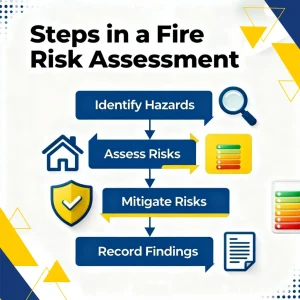
A fire risk assessment. helps landlords understand their fire safety responsibilities and keep their property safe. It looks at every part of the building to find what can cause a fire and how to stop it. The process also checks fire alarms, escape routes, and safety equipment to make sure everything works properly. By doing this, landlords protect tenants, reduce fire risks, and follow UK fire safety laws with confidence.
Get Your Free Checklist Now
Check Your Property Today and Keep Your Tenants Safe.
Download the Guide and Make Fire Safety Simple and Easy.
Identifying and Mitigating Potential Fire Hazards
Finding fire hazards early helps you fix problems before they cause harm. Here’s how:![]() Look for overloaded sockets and poor wiring.
Look for overloaded sockets and poor wiring.![]() Monitor appliances for faults and signs of damage.
Monitor appliances for faults and signs of damage.![]() Remove clutter that can catch fire easily.
Remove clutter that can catch fire easily.![]() Ensure heaters and cooking appliances are used safely.
Ensure heaters and cooking appliances are used safely.![]() Keep escape routes free from obstacles.
Keep escape routes free from obstacles.![]() Check for solid fuel burning appliance compliance, such as coal fires.
Check for solid fuel burning appliance compliance, such as coal fires.![]() Store chemicals and flammable goods safely away.
Store chemicals and flammable goods safely away.![]() Look for electrical safety issues across all rooms.
Look for electrical safety issues across all rooms.![]() Remove obstructions in corridors to keep exits clear.
Remove obstructions in corridors to keep exits clear.
When and How Often to Review Your Fire Risk Assessment
Regular reviews keep the fire risk assessment up to date in the property or for tenants. Take a look at this list:![]() Update the assessment after any renovation or when new furniture is added.
Update the assessment after any renovation or when new furniture is added.![]() Recheck fire safety equipment every six months.
Recheck fire safety equipment every six months.![]() Review if tenancy changes or new occupants move in.
Review if tenancy changes or new occupants move in.![]() Adjust procedures after any fire-related incident.
Adjust procedures after any fire-related incident.![]() Follow government guidance for periodic review intervals.
Follow government guidance for periodic review intervals.![]() Carry out a full review annually or when any major change occurs.
Carry out a full review annually or when any major change occurs.![]() Reassess immediately after any fire safety incident.
Reassess immediately after any fire safety incident.
What Should Be Included in a Landlord’s Fire Safety Certificate?
A landlord’s fire safety certificate confirms that the property meets all legal fire safety regulations. This includes:![]() A full fire risk assessment.
A full fire risk assessment.![]() Details of fire detection and alarm systems.
Details of fire detection and alarm systems.![]() Emergency lighting.
Emergency lighting.![]() Fire doors.
Fire doors.![]() Clear escape routes.
Clear escape routes.
Proof that fire safety equipment is properly maintained and tested by a qualified professional.
Requirements for Obtaining a Fire Safety Certificate
To get a fire safety certificate, landlords must ensure that their property follows key regulations. These are:
![]() Completion of a fire risk assessment
Completion of a fire risk assessment![]() Confirmation that smoke and carbon monoxide alarms are in place.
Confirmation that smoke and carbon monoxide alarms are in place.![]() Functional escape route.
Functional escape route.![]() Serviced and worked on fire extinguishers.
Serviced and worked on fire extinguishers.![]() Verified emergency lighting and fire doors.
Verified emergency lighting and fire doors.![]() Up-to-date gas safety and electrical safety documentation.
Up-to-date gas safety and electrical safety documentation.
Renewal Process and Validity Period
To keep a fire safety certificate, landlords need to do some regular things, like:
![]() The certificate lasts for one year.
The certificate lasts for one year.![]() It must be renewed every year.
It must be renewed every year.![]() During yearly checks, alarms and extinguishers get tested.
During yearly checks, alarms and extinguishers get tested.![]() If the building changes a lot, the certificate needs updating right away.
If the building changes a lot, the certificate needs updating right away.![]() Regular fire safety checks and risk reviews keep the certificate valid.
Regular fire safety checks and risk reviews keep the certificate valid.![]() Not renewing on time can lead to fines or other trouble.
Not renewing on time can lead to fines or other trouble.![]() Keeping the certificate current helps protect both tenants and landlords.
Keeping the certificate current helps protect both tenants and landlords.
Professional Certification vs. Self-Certification Options
As a landlord, you have two choices to get a fire safety certificate. That is hiring a pro or doing it yourself. Here’s a simple table showing the difference between that:
Aspect
Professional Certification
Self-Certification
Certifier
Licensed fire safety professional
Landlord or property manager
Inspection Detail
Comprehensive, following formal
guidelines
Basic, relying on the landlord’s own checks
Credibility & Acceptance
Widely accepted by authorities
and insurers
May be limited or not accepted in some areas
Cost
Higher due to professional fees
Lower or no cost
Legal Risk
Lower risk due to expert validation
Higher risk if non-compliance is found
Aspect
Professional Certification
Self-Certification
Certifier
Licensed fire safety professional
Landlord or property manager
Inspection Detail
Comprehensive, following formal guidelines
Basic, relying on the landlord’s own checks
Credibility & Acceptance
Widely accepted by authorities and insurers
May be limited or not accepted in some areas
Cost
Higher due to professional fees
Lower or no cost
Legal Risk
Lower risk due to expert validation
Higher risk if non-compliance is found
What Are the Specific Fire Safety Checks for HMOs and Multi-Occupancy Buildings?
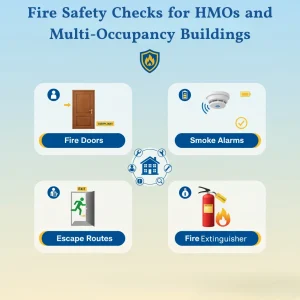
Here we talk about the key fire safety checks for landlords in HMOs and multi-occupancy buildings.
![]() Smoke alarms: Check they are installed in all required areas and working.
Smoke alarms: Check they are installed in all required areas and working.![]() Fire doors: Ensure doors close properly and aren’t damaged or blocked.
Fire doors: Ensure doors close properly and aren’t damaged or blocked.![]() Escape routes: Keep corridors, stairways, and exits clear at all times.
Escape routes: Keep corridors, stairways, and exits clear at all times.![]() Fire extinguishers: Confirm they are present, appropriate, and serviced.
Fire extinguishers: Confirm they are present, appropriate, and serviced.![]() Emergency lighting: Test lights in common areas and escape routes.
Emergency lighting: Test lights in common areas and escape routes.![]() Electrical safety: Inspect wiring, plugs, and sockets for hazards.
Electrical safety: Inspect wiring, plugs, and sockets for hazards.![]() Gas safety: Annual checks by a registered Gas Safe engineer.
Gas safety: Annual checks by a registered Gas Safe engineer.![]() Fire risk assessment: Review and update regularly.
Fire risk assessment: Review and update regularly.![]() Evacuation plan: Clearly displayed and known to all occupants.
Evacuation plan: Clearly displayed and known to all occupants.![]() Records: Keep logs of all fire safety checks and maintenance.
Records: Keep logs of all fire safety checks and maintenance.
Additional Legal Requirements for HMO Properties
HMO landlords must follow specific legal duties under the Housing Act 2004, the Licensing of Houses in Multiple Occupation (HMO) Regulations, and the Fire Safety (England) Regulations 2022. Here are the key regulations:
![]() Install smoke and carbon monoxide alarms on every floor.
Install smoke and carbon monoxide alarms on every floor.![]() Ensure emergency lighting works in shared areas.
Ensure emergency lighting works in shared areas.![]() Keep escape routes clear and add clear signage.
Keep escape routes clear and add clear signage.![]() Complete a fire risk assessment for the whole building.
Complete a fire risk assessment for the whole building.![]() Display fire safety information for tenants.
Display fire safety information for tenants.![]() Maintain alarms, fire doors, and other safety equipment regularly.
Maintain alarms, fire doors, and other safety equipment regularly.
Fire Escape Routes and Emergency Procedures
Escape routes are very important for getting out safely in an emergency. Landlords must ensure that are safe and easy to reach. Here’s how:![]() Clear, unobstructed, and easy to access at all times.
Clear, unobstructed, and easy to access at all times.![]() Fitted with emergency lighting in HMOs and multi-storey buildings.
Fitted with emergency lighting in HMOs and multi-storey buildings.![]() Clearly marked with fire exit signs were required.
Clearly marked with fire exit signs were required.![]() Supported by written evacuation plans shared with all tenants. Also, give information about the importance of this, showing the fastest and safest way out of the building.
Supported by written evacuation plans shared with all tenants. Also, give information about the importance of this, showing the fastest and safest way out of the building.
Fire Door Specifications and Maintenance
Fire doors are the most essential safety feature in HMOs, multi-occupancy buildings, and high-rise residential buildings. That’s why, landlords must:
![]() Must be fire-rated and meet current UK standards.
Must be fire-rated and meet current UK standards.![]() Must close automatically and not be blocked or damaged.
Must close automatically and not be blocked or damaged.![]() Carry out regular fire door safety checks.
Carry out regular fire door safety checks.![]() Maintain smoke seals and intumescent strips.
Maintain smoke seals and intumescent strips.![]() Record all inspections for compliance.
Record all inspections for compliance.![]() Include flat entrance doors and communal fire doors in annual checks.
Include flat entrance doors and communal fire doors in annual checks.
How To Check Fire Alarm Systems in Rental Properties?
To keep tenants safe and stay compliant, all landlords must follow these essential steps for checking fire alarm systems:
![]() Install smoke alarms on every floor of the property.
Install smoke alarms on every floor of the property.![]() Fit carbon monoxide alarms in rooms with solid fuel appliances.
Fit carbon monoxide alarms in rooms with solid fuel appliances.![]() Test all alarms at the start of each tenancy to ensure they work.
Test all alarms at the start of each tenancy to ensure they work.![]() Conduct a fire risk assessment if renting to three or more unrelated tenants.
Conduct a fire risk assessment if renting to three or more unrelated tenants.![]() Ensure compliance with UK fire safety regulations for HMOs and rental properties.
Ensure compliance with UK fire safety regulations for HMOs and rental properties.
Testing Procedures for Smoke and Heat Detectors
To ensure alarms work properly, landlords need to test smoke and heat detectors regularly:![]() Smoke detectors: Test monthly using the test button or smoke spray.
Smoke detectors: Test monthly using the test button or smoke spray.![]() Heat detectors: Test monthly with the test button or professional heat equipment.
Heat detectors: Test monthly with the test button or professional heat equipment.![]() Interlinked alarms: Ensure all alarms sound when one is triggered.
Interlinked alarms: Ensure all alarms sound when one is triggered.![]() Professional inspection: Have a qualified technician inspect the system at least once a year.
Professional inspection: Have a qualified technician inspect the system at least once a year.![]() Check devices for damage or obstructions that may prevent proper functioning.
Check devices for damage or obstructions that may prevent proper functioning.
Documentation Requirements for Alarm Testing
To stay compliant and prove safety, landlords need to keep clear records of all fire alarm checks:![]() Keep a log of all tests, including date, results, and actions taken.
Keep a log of all tests, including date, results, and actions taken.![]() Record battery replacements and repairs or maintenance.
Record battery replacements and repairs or maintenance.![]() Maintain annual inspection reports from professionals.
Maintain annual inspection reports from professionals.![]() Inform tenants of their responsibility to test alarms monthly and report faults.
Inform tenants of their responsibility to test alarms monthly and report faults.![]() Proper documentation ensures compliance, safety, and insurance coverage.
Proper documentation ensures compliance, safety, and insurance coverage.
What Are the Fire Door Safety Checks for Landlords?
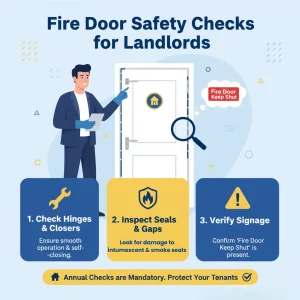
Landlords must meet minimum requirements to keep blocks of flats and hmos and buildings safe. All fire doors should be installed on every entrance and kept in working order at the start of tenancy. The importance of fire doors is critical to prevent electrical fires and other hazards. Private landlords must protect your property and ensure regulations apply. Landlords are responsible to provide residents with guidance and keep contact details of the responsible local fire and rescue service. The use of firefighters in emergencies highlights the need for compliance.
Legal Requirements for Fire Doors in Different Property Types
All fire doors must meet UK safety standards and have proper certification. It’s a legal duty for the landlord. Fire doors are common in different types of property:![]() Houses in Multiple Occupation (HMOs): Fire doors are needed between flats and shared areas.
Houses in Multiple Occupation (HMOs): Fire doors are needed between flats and shared areas.![]() Apartment blocks and flats: Fire doors in flats and common areas stop fire spreading.
Apartment blocks and flats: Fire doors in flats and common areas stop fire spreading.![]() Single-family rental homes: Fire doors make kitchens, boiler rooms, and garages safer.
Single-family rental homes: Fire doors make kitchens, boiler rooms, and garages safer.![]() Student accommodation: Fire doors protect rooms and corridors where many people live.
Student accommodation: Fire doors protect rooms and corridors where many people live.![]() Care homes and sheltered housing: Fire doors separate rooms and hallways to keep residents safe.
Care homes and sheltered housing: Fire doors separate rooms and hallways to keep residents safe.![]() Commercial rental properties with living spaces: Fire doors protect living areas and escape routes.
Commercial rental properties with living spaces: Fire doors protect living areas and escape routes.
How To Inspect Fire Doors for Compliance
Landlords need to check fire doors carefully. This ensures the doors work well and keep people safe. Here is a simple way to do it:![]() Check the door and frame for damage.
Check the door and frame for damage.![]() Make sure hinges, locks, and closers work.
Make sure hinges, locks, and closers work.![]() Inspect strips that expand in fire.
Inspect strips that expand in fire.![]() Check the “Fire Door Keep Shut” sign.
Check the “Fire Door Keep Shut” sign.![]() Close the door to test it.
Close the door to test it.
What Are the Emergency Lighting Checks for Rental Properties?
Emergency lighting checks make sure that all lights used during an emergency, like power cuts or fires, work properly. Landlords should check that emergency lights in hallways, staircases, corridors, and communal areas turn on when needed. Key points for landlords:![]() Ensure all emergency lights are working.
Ensure all emergency lights are working.![]() Test lights and batteries regularly.
Test lights and batteries regularly.![]() Make sure escape routes are clear.
Make sure escape routes are clear.![]() Keep a record of each check.
Keep a record of each check.
Requirements For Emergency Lighting in Common Areas
Emergency lighting is a key part of fire safety in any rental property. That’s why landlords must make sure:![]() Emergency lights must meet BS 5266-1 standards and have the correct battery backup.
Emergency lights must meet BS 5266-1 standards and have the correct battery backup.![]() Install emergency lights in staircases, corridors, and other shared areas.
Install emergency lights in staircases, corridors, and other shared areas.![]() Ensure lights illuminate escape routes clearly.
Ensure lights illuminate escape routes clearly.![]() Check that exit signs are visible and correctly positioned.
Check that exit signs are visible and correctly positioned.![]() Keep all emergency lighting free from obstructions.
Keep all emergency lighting free from obstructions.
Testing And Maintenance Schedule for Emergency Lighting
Landlords have a legal duty to ensure all lights are regularly checked and maintained. Here’s how a landlord can do these checks:![]() Test lights regularly to confirm they work in case of a power failure.
Test lights regularly to confirm they work in case of a power failure.![]() Replace faulty bulbs or batteries immediately.
Replace faulty bulbs or batteries immediately.![]() Keep a log of all inspections, tests, and maintenance.
Keep a log of all inspections, tests, and maintenance.![]() Full annual checks to meet legal requirements.
Full annual checks to meet legal requirements.
What Fire Safety Equipment Must Landlords Provide?
To protect tenants and align with UK fire safety regulations, landlords must provide the right fire safety equipment. It’s a duty for all landlords to check this equipment regularly. Here is the equipment list:
![]() Smoke alarms are on every floor of the property.
Smoke alarms are on every floor of the property.![]() Carbon monoxide alarms in any room with a gas or solid fuel appliance.
Carbon monoxide alarms in any room with a gas or solid fuel appliance.![]() Fire extinguishers in HMOs and shared areas.
Fire extinguishers in HMOs and shared areas.![]() Annual servicing and safety checks for all fire extinguishers.
Annual servicing and safety checks for all fire extinguishers.![]() Fire blankets in every kitchen.
Fire blankets in every kitchen.![]() A multi-purpose fire extinguisher is on each level of the property.
A multi-purpose fire extinguisher is on each level of the property.![]() Emergency lighting in corridors, stairways, and escape routes (for HMOs and multi-occupancy buildings).
Emergency lighting in corridors, stairways, and escape routes (for HMOs and multi-occupancy buildings).![]() Clearly marked fire exit signs were required
Clearly marked fire exit signs were required![]() Written fire safety instructions for tenants, including how to use fire equipment.
Written fire safety instructions for tenants, including how to use fire equipment.![]() Regular testing and maintenance of all alarms, extinguishers, and lighting systems.
Regular testing and maintenance of all alarms, extinguishers, and lighting systems.
Smoke And Carbon Monoxide Alarm Requirements
Landlords must keep tenants safe from smoke and gas. Main responsibilities include:![]() Install smoke alarms on every floor of the property.
Install smoke alarms on every floor of the property.![]() Place carbon monoxide alarms in rooms with gas or solid fuel appliances.
Place carbon monoxide alarms in rooms with gas or solid fuel appliances.![]() Ensure alarms work at the start of every tenancy.
Ensure alarms work at the start of every tenancy.![]() Test alarms regularly to maintain full functionality.
Test alarms regularly to maintain full functionality.![]() Replace batteries or faulty alarms immediately.
Replace batteries or faulty alarms immediately.![]() Keep a record of all tests and maintenance.
Keep a record of all tests and maintenance.
Fire Extinguisher Regulations and Maintenance
Fire extinguishers help tenants act fast in an emergency, but only if they are kept in good condition. Landlords must:![]() Fire extinguishers are required in HMOs and shared areas.
Fire extinguishers are required in HMOs and shared areas.![]() Conduct annual servicing by a qualified engineer.
Conduct annual servicing by a qualified engineer.![]() Check pressure, expiry dates, and overall condition regularly.
Check pressure, expiry dates, and overall condition regularly.![]() Place extinguishers in visible and easily accessible locations.
Place extinguishers in visible and easily accessible locations.![]() Train tenants on basic extinguisher use.
Train tenants on basic extinguisher use.![]() Keep a log of all inspections and maintenance.
Keep a log of all inspections and maintenance.
Fire Blankets and Other Safety Equipment Considerations
Extra fire safety equipment helps tenants stay safe in a fire. Landlords check the equipment, ensure it works, and keep it ready to use. Here’s how:![]() Provide fire blankets in every kitchen.
Provide fire blankets in every kitchen.![]() Place multi-purpose extinguishers on each level.
Place multi-purpose extinguishers on each level.![]() Display clear fire safety instructions for tenants.
Display clear fire safety instructions for tenants.![]() Keep all equipment visible and easy to reach.
Keep all equipment visible and easy to reach.![]() Replace damaged or expired equipment immediately.
Replace damaged or expired equipment immediately.![]() Educate tenants on the proper use of fire blankets and extinguishers.
Educate tenants on the proper use of fire blankets and extinguishers.
How Fire Safety Interacts with Gas and Electrical Safety in Rental Properties
Fire safety depends on safe gas and electrical systems. That’s why landlords must take care of it. Here’s how:![]() Keep gas appliances and wiring in good condition.
Keep gas appliances and wiring in good condition.![]() Fix faults immediately with qualified professionals.
Fix faults immediately with qualified professionals.![]() Educate tenants on safe appliance use.
Educate tenants on safe appliance use.
Why Gas Safety Checks Also Support Fire Risk Prevention
Gas checks help keep everyone safe from fires and gas leaks. Here’s what landlords should do:![]() Arrange annual Gas Safe inspections.
Arrange annual Gas Safe inspections.![]() Service all gas appliances regularly.
Service all gas appliances regularly.![]() Act quickly on any defects.
Act quickly on any defects.
The Role of Electrical Safety in Preventing Fires
Electrical safety keeps your home safe from sparks and fires. Landlords should:![]() Inspect wiring and appliances regularly.
Inspect wiring and appliances regularly.![]() Replace damaged equipment immediately.
Replace damaged equipment immediately.![]() Use RCDs and avoid overloading circuits.
Use RCDs and avoid overloading circuits.
As a landlord, fire safety is important. Make sure you’re following the latest rules to keep your tenants and property safe. AllLandlordCertificates.co.uk offers expert services for Domestic & Commercial Electrical Safety Certificates, Gas Safety Certificates (CP12), Emergency Lighting Certificates, Fire Alarm Certificates, and EPC Certificates. Don’t risk fines or safety issues. Reach out to AllLandlordCertificates.co.uk today for all your fire safety needs.

